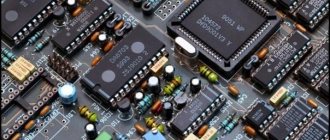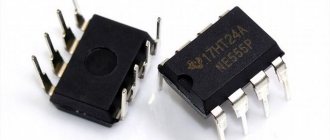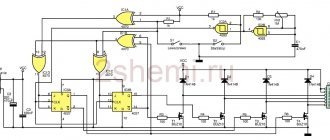You and I become “victims” of marketing triggers when we read posts on social networks, watch videos on YouTube, listen to the radio in the car, or come across outdoor advertising. Triggers work like a magnet for our attention - we respond to what touches and excites us. Articles about triggers usually show how big brands get our attention through advertising. But this article is for those who want to use the power of triggers for personal advancement. It is for those who need to constantly create content, influence the audience, captivate them and achieve the desired reactions.
Definition
What is a trigger? A trigger is an electronic device that has the ability to remain in one of two stable states for quite a long time, as well as alternate between them due to the influence of some external signal. A trigger is essentially a simple piece of electronics on which the performance of more complex systems depends.
It is capable of storing binary information (zero or one) after the input pulses cease to operate. The main purpose of the device is to switch from one state to another. The trigger stores 1 bit of information in its memory, which determines its current state: logical “0” or logical “1”.
What inputs does a trigger have? Any trigger can have several inputs, which are:
- Informational. They are responsible for the general condition of the device at the time of operation of the entire circuit.
- Managers. They are responsible for setting the trigger to a preliminary position and for its further synchronization.
The operation of the device is based on 2 elements “AND-NOT”, 2 “OR-NOT” and others; some types of flip-flops operate on logical elements CMOS, TTL, ESL. The operating principle of any trigger depends on the number of inputs/outputs, as well as on the type of device itself.
Electronics uses devices based on transistors or microcircuits. Transistor models are used for complex integrated circuits of the old type. The logic chip is smaller in size and stores information without overheating or overloading. Therefore, they are used in smaller and more complex circuits of modern electronics.
How buyers make decisions
The first and most important thing to understand is the purchasing decision process. It consists of 4 main phases: the emergence of intention, product analysis, purchase and feedback from the store.
Despite the fact that the decision-making algorithm is fair for everyone, this is where the differences between clients begin. They can be seen most clearly by considering conscious and spontaneous buyers. The former pay more attention to the quality of the product and think through shopping lists, while the latter make most purchases under the influence of various kinds of emotions.
By understanding which group of users your brand is designed for, you can more clearly build your positioning. For example, offering conscious customers products in “looks” or sets, or using shopping bags and emphasizing the company’s environmental mission.
Varieties
In order to understand how a trigger works, you need to understand what class and type it belongs to. There are 2 main classes of these devices:
- Synchronous with two main classes: static and dynamic.
- Asynchronous.
Both varieties have a similar operating principle. The difference lies only in the process of transition of the signal from one state to another. Asynchronous ones do this directly, while synchronous ones work based on this signal.
Asynchronous
An asynchronous RS flip-flop has 2 main inputs “R” and “S”. Outputs “Q” and “Q−” are also provided. The RS trigger device allows the following sequence:
- Input “S” is installation. A high voltage is applied to it, as a result of which the logic output “Q” is set to “1”.
- Input "R" is responsible for resetting the position. A high voltage in the form of a logical “1” at this input implies a 0 setting at the “Q” output, and a “1” setting at the “Q–” output.
An asynchronous RS flip-flop works as follows:
- When voltage is applied to the “S” input, the device turns on and maintains this state even if the positive signal is lost.
- When a signal is applied to the “R” input, the device turns off, while maintaining a logical 0 at the outputs.
The asynchronous type RS flip-flop circuit is the simplest. It works without synchronization with the auxiliary input. The RS component is used in simple elements or as an addition to more complex triggers.
Next, the UGO, the truth table and the general diagram of such a trigger will be presented.
Synchronous
A slightly more complex device. They work with additional signal synchronization. These RS flip-flops also have "R" and "S" inputs, as well as "Q" and "Q–" outputs. The difference is the presence of a synchronizing input “C”. This contact is needed to synchronize incoming signals. This input is called “clock” or clock. The trigger has the following operating principle:
- Initially, the signal arrives at the input contact “C” and undergoes synchronization.
- From contact “C” the signal is sent to input “S” in the form of logical 1 or high voltage.
- Logic 1 is set to “Q”, and the circuit itself is turned on.
Synchronization is used to reduce some of the interference. Often, RS flip-flops of this type are used for parallel-connected circuits, significantly reducing interference from elements with high magnetic inductance.
The graphical symbol, truth table and steady state diagram of the device are presented below.
Asynchronous and synchronous models are far from the only ones that circuitry uses to build logical models of operation. Next, we will present types of triggers with a different operating principle.
D-trigger
These types of simple flip-flops also use one bit of memory to store information about their current state. It is used in simple electronic circuits of computing devices and automation. This model also belongs to the synchronous type and has an input “C”. The main difference is the replacement of 2 “RS” inputs with one “D” contact. The use of only one input and the presence of synchronization can significantly simplify the operation of the device. The following circuit is used to operate the D-flip-flop:
- Pin “C” receives a logic 1 signal or high voltage.
- The signal is synchronized.
- Receives input pin D.
- If the output “Q” was in the logical 1 state, then it turns on.
- If the "Q" output was logic 0 or this contact was in the reset state, a logic 1 is sent to the "Q−" output.
In other words, the output state of the flip-flop depends on its previous position. If the previous position was in a high voltage state, then this output will be logic 1. If the position was in a reset state, then logic 0.
Almost all D-triggers are dynamic. When dynamically controlling the state of a trigger, the concept of an edge is used. A front is a transition from 1 to 0. There are 2 types of front:
- Front. In this position, a transition from 0-1 is carried out.
- A falling edge is a signal transition from 1 to 0.
There are varieties of D devices with an additional input V. The name of this input stands for test. Such an element works with some slowdown. It is necessary for preliminary synchronization of the signal, with its subsequent confirmation. In this case, it does not matter much how much memory is occupied in the device. Conventional and DV flip-flops are designed to work in complex devices with many cells. For example, in electronic meters, these devices are responsible for the current value. When it changes, the state of the trigger changes its front.
The following is a table of truth and UGO of fronts.
How the brain works and why high-quality visual content is more important than big discounts
What influences decision making? People remember 10% of what they hear, 80% of what they see and 20% of what they read.
Most people are visual people. This means that even the biggest bargain hunters will pay attention to product photos, store visuals, and email newsletter design.
65% of information comes visually . This is why 93% of buyers will choose a more expensive product if it looks better. For online, the situation is similar: in fact, here, besides the visual, there are no other ways to form an opinion about the product.
T-trigger
T flip-flops on logic gates include many of the features of previously described devices. There are models of asynchronous and synchronous types, dynamic and with an additional confirmation input.
Asynchronous
When a positive signal is received at the input, the output voltage is 2 times higher than the input. This effect is only possible with a pulse signal arriving at the T input. At the same time, the frequency of arrival on the time scale has no obstacles, which means the signal arrives much faster. Asynchronous T devices in the logical 1 state at the output have an antiphase inverted output.
Synchronous
These T flip-flops are similar to asynchronous ones. The exception is the presence of a clock signal at the input. There is also antiphase at the inverse output and the appearance of double voltage.
The design of T elements can easily be classified as pulse signal dividers. These elements only work when there is a leading edge. In other words, there is a transition from 0 to 1. But the difference lies in taking into account the time interval between pulses.
Type T flip-flops are often used in logic computing processes. This is done through the function of increasing or decreasing the voltage:
- When the output frequency increases from logical 1, a positive number is written.
- When the frequency decreases at the inverse output at logical 0, a negative number is written.
When taking into account how much memory is needed to transition and divide the signal, the element can be supplemented with an acknowledgment input. Programming using a T-flip-flop allows the device to be used in various electronic meters without built-in memory. The following is a diagram of the device's operation.
Lifehacks from large companies to create a selling atmosphere
For retail sharks, all of the above triggers are not new; they are actively used and consistently generate revenue. However, the company's success comes not so much from attention to detail, but from its compliance with the positioning and mission of the brand. For example, Nike uses distinctive music with vibrations, and Victoria's Secret uses soothing melodies to facilitate communication between customers and staff.
In Apple stores you always want to touch the product. The company specifically creates this desire by opening laptops 70 degrees , because after touching, the buyer on a subconscious level considers the thing his own.
Hugo Boss uses a unique combination of musk and citrus to create a clear associative connection with the store and engage the customer's memory triggers.
JK trigger
It is the most versatile electronic element. These devices contain:
- Inputs “J” and “K” as information ones. In this case, “J” is the usual “S” input, and “K” is the “R” input.
- "C" - dynamic input.
- "R" and "S" are static.
The JK device operates on the principle of transition from one state to another, but taking into account a unit of time. There is also a difference when applying a signal to the synchronization input. In other words, if a logical 1 is applied to both inputs of JK, then the exact opposite value will appear at its outputs. But the device will not perceive the presence of two 1 units as an error.
Depending on the purpose, this trigger can use the so-called edge (leading or trailing). In this case, the device is considered synchronous, and its state is determined by the current position of the logical numbers. When calculating the operating state of an element, the possibility of simultaneous use of the device as a T or D trigger is also taken into account. In this case, the parameter of the time interval of signal arrival, what voltage will be received at output and the stability of the element’s state are taken into account. Computer science often uses this element as a universal device for monitoring the state of stable operation of simple logical functions. The following is a diagram of the device's operation.
Symmetric
A symmetrical trigger refers to a special type of element. It is created using transistors and is a two-stage DC amplifier. The device operates by using transistors with completely identical parameters.
The operating principle is as follows:
- When voltage is applied to the device, transistor VT1 is considered open. Its collector voltage is 0.
- At this moment, transistor VT2 is closed. Its collector has a positive voltage.
- To effect a transition from one state to another, a voltage pulse is used. This pulse is created by a capacitor.
- When a pulse appears, the transistors change their state.
When changing the position of the transistors, a voltage drop is created and it decreases significantly.
In symmetrical flip-flop circuits, the main element is the triggering system. It may differ in the control method and the place from which the starting impulse came.
- Separate control. Involves supplying voltage to a specific trigger input. With this control, the element is considered an RS trigger.
- General or accounting management. Voltage is supplied to the common input pin. With this connection, the device is similar in parameters to a T-trigger.
The source of the pulse can be from the collector or base of the transistor. With such connection schemes, there is a possibility of a false or secondary signal. It is cut off by connecting a diode.
The main disadvantage of symmetrical elements is their complete dependence on the time of arrival of the pulse signal and its duration. If the duration is insufficient, the pulse will not have time to open the transistor, which means the second transistor will not close.
Such devices are used in pulse metering devices, frequency generators, and radio-electronic circuit switches.











